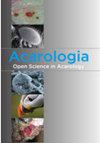Free-living mites (Acari) of the Franz Josef Land Archipelago, the coldest Old World territory: diversity, geographic distributions, assemblages
IF 1.1
3区 农林科学
Q3 ENTOMOLOGY
引用次数: 0
Abstract
Studies on the mites from the Franz Josef Land Archipelago have become strongly belated and impeded because of the archipelago’s highly remote location (1,500 km from the mainland) and logistics barriers. Material collected during five expeditions (1981−2016) has revealed a total of 48 species of free-leaving mites, yet two species are added based on literature data (absent in the present material). Altogether, 17 families, 22 genera, and 23 species are reported for the first time to inhabit the archipelago. The presence of 16 from 26 previously recorded species must be confirmed. Like in the other parts of the polar desert zone, arachnids (52 species, including two spider species found in previous works) generally appear to be more diverse than insects (14 species, found in previous and present works), this being a unique feature of that natural zone. Prostigmatic mites (19 species) are twice as diverse as oribatid mites (10 species). The mesostigmatic mite genus Arctoseius Thor, 1930 is the most species-rich (8 species of all 13 mesostigmatic mite species collected), as previously reported throughout the Arctic. The acarofauna is strongly fragmentary, 23 of all 30 genera (76.7%) being represented by one species each. The fauna of Mesostigmata is much more specialized (in terms of cryophily) in comparison to Oribatida, true arctic and arctic-montane species amounting to 92% versus 10%, respectively. The total mite abundance varies between 120 and 3,760 ind./dm2, being the maximal in a tundra-like habitat on a south-faced slope in Tikhaya Bay, Hooker Island. Small and thin-tegumented members of Eupodidae, Tydeidae and Nanorchestidae, all using liquid food alone, predominate everywhere across the archipelago as they do throughout the polar deserts of both Hemispheres. Small oribatids (Liochthonius spp., Brachychthoniidae) are often also abundant. All these taxa represent the most ancient lineages of the superorder Acariformes known to date back to the early or middle Devonian. The rather large and well-sclerotized members of the oribatid family Ceratozetidae are abundant only in the best heated habitats with an extended vegetation season.旧世界最寒冷地区弗朗兹约瑟夫地群岛的自由生活螨虫(螨类):多样性、地理分布和组合
由于弗朗兹约瑟夫地群岛地处偏远(距大陆 1,500 公里),加之物流障碍,对该群岛螨类的研究已经严重滞后和受阻。五次考察(1981-2016 年)中收集的材料共发现 48 种自由离体螨,但根据文献数据又增加了两个物种(本材料中没有)。据报道,共有 17 科、22 属和 23 种螨虫首次栖息于该群岛。之前记录的 26 个物种中有 16 个物种的存在必须得到证实。与极地沙漠区的其他地方一样,蛛形纲动物(52 种,包括以前发现的两个蜘蛛种类)的种类似乎普遍多于昆虫(14 种,在以前和现在的作品中均有发现),这是该自然区的一个独特特征。拟态螨(19 种)的多样性是兽螨类(10 种)的两倍。中柱螨属 Arctoseius Thor(1930 年)的种类最为丰富(在收集到的所有 13 种中柱螨中有 8 种),这与以前在整个北极地区的报告相同。螨类动物群非常零散,在所有 30 个属中,有 23 个属(76.7%)只有一个物种。与 Oribatida 相比,Mesostigmata 动物群(就嗜冷性而言)更为特化,真正的北极和北极-山地物种分别占 92% 和 10%。螨类的总丰度在 120 至 3,760 ind./dm2 之间,在胡克岛提哈亚湾南面斜坡上的冻原栖息地中丰度最高。大戟科(Eupodidae)、蝾螈科(Tydeidae)和鲣鱼科(Nanorchestidae)的小型薄皮成员都只以液态食物为生,它们在群岛各处都占主导地位,就像它们在两个半球的极地沙漠中一样。此外,还经常出现大量的小型鸟类(Liochthonius 属、Brachychthoniidae)。所有这些类群都代表了已知可追溯到泥盆纪早期或中期的蛛形纲超目中最古老的类群。只有在植被生长期较长、温度适宜的栖息地中,才会大量出现体型较大、硬壳化程度较高的口蝠科(Ceratozetidae)成员。
本文章由计算机程序翻译,如有差异,请以英文原文为准。
求助全文
约1分钟内获得全文
求助全文
来源期刊

Acarologia
ENTOMOLOGY-
CiteScore
2.00
自引率
18.20%
发文量
81
期刊介绍:
Acarologia is a free open-access journal. Please help us by submitting manuscripts in accordance with following instructions.
All manuscripts which do not conform to the instructions will be returned to authors without the benefit of review.
Acarologia publishes the results of original research on all aspects of Acarology.
The journal policy is that taxonomic descriptions should include several species within a same genus/family, when possible.
The editors reserve the right to refuse manuscripts when authors intentionally divide individual species descriptions of the same genus/family into distinct publications.
Single species descriptions should be clearly justified based on their scientific interest.
 求助内容:
求助内容: 应助结果提醒方式:
应助结果提醒方式:


